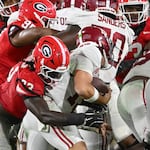ATHENS — Big-time college sports are becoming more like professional sports each day with NIL payments, open transfer policies and expanded playoffs.
Next, it’s time for more transparency when it comes to player availability for high-profile games with the proliferation of legalized sports gambling.
RELATED: SEC TV schedule, betting lines for this weekend’s big games
More than half of the states in the country allow for sports betting since a Supreme Court ruling opened the door in May of 2018 by striking down a 1992 federal law.
Four of the 11 SEC states — Mississippi, Louisiana, Tennessee and Arkansas — allow sports betting.
A 2016 NCAA Compliance on sports wagering revealed eye-popping numbers on the number of student-athletes partaking in gambling:
• 24 percent of male student-athletes reported on wagering on sports in the last year
• 9 percent of males reported on wagering on sports once a month or more
• 1 in 50 male student-athletes meet standard diagnostic criteria for problem gambling
• 4 percent of male student-athletes who gambled in the past year reported one-day gambling losses of $500 or more
Keep in mind, those numbers were reported before sports betting was legalized.
The temptation has likely never been greater for student-athletes to gamble, as they have more money on their hands than ever.
“How common is it?” one former coach said. “How many schools are there? 131? Then it’s happening at 131 of them.”
SEC commissioner Greg Sankey said on the SEC Network last spring that “nearly $2 billion” was wagered on league sports through the academic calendar.
Sankey has addressed sports gambling issues several times, pointing out the strain put on student-athletes and the support personnel around the programs with gamblers seeking insider information that affects the outcome or individual performances in games.
Kentucky coach Mark Stoops, who is in his 10th year in the league, said it’s hard to hide players’ injuries, anyway.
“There’s enough information out there, whether it’s tied back to gambling or not, there’s going to be people out there on campus watching and noticing if they are in a boot or on crutches or whether they are out,” Stoops said on Wednesday.
“My take is if I know a player is definitely out, I say it as early as I know. That’s just my take, so I’m not sure where we are at as a league or with the NCAA with that issue.”
But, Stoops added, “Some of that you have to play close to the vest, you don’t want to give your competitors an advantage.”
Georgia coach Kirby Smart, like Stoops, is relatively transparent when asked by media members about player injuries.
But Smart and the Bulldogs are among eight programs out of the 131 in the FBS ranks not to release an updated travel/dress chart before games, per an action network report earlier this fall.
The concept of hiding player availability is to the extent that in 2019, the SEC mandated players warming up before games wear apparel with corresponding uniform numbers.
Former Florida coach Dan Mullen went on a rant indicating he felt Georgia triggered the rule by turning in his Gators for their warm-up gear.
RELATED: How Dan Mullen implicated Georgia for triggering new rule
Sankey, recognizing in 2018 how gambling activity might spike in a passionate conference like the SEC, immediately addressed a future with availability reports.
“The change in sports gambling could be and will be likely the impetus for the creation of such reports in our future,” Sankey said at the 2018 SEC Spring Meetings in Destin, Fla., per a Jacksonville.com story.
Sankey explained then the nature of college athletics — with medical privacy laws for those under 21 and the in-house nature of academic and disciplinary suspicions — would make for more of a list of which players are available, rather than listing which ones are not, as commonly seen in pro leagues.
Texas A&M coach Jimbo Fisher said he wants to do what is best for student-athletes, but he would also want assurance the policy would be equal and enforced.
“If it’s universal across the board, whatever it is, good bad or indifferent, I think it’s always fair,” Fisher said on the SEC Coaches Teleconference.
“If it’s fair and good for the kids, then it’s something that could happen, for sure.”
Ole Miss coach Lane Kiffin, who dealt with injury reports as the one-time coach of the Oakland Raiders, said compliance is always key to rule changes.
“There’s all kinds of things that have trickled down (from the NFL) that may seem like it would make sense,” said Kiffin, citing targeting rules and other issues. “But if they make rules, folks would have to abide by them.”
While football and basketball get the most “action,” Sankey indicated at an Associated Press Sports Editors conference in Indianapolis last June that gambling trends are spreading.
“It was football and men’s basketball and women’s basketball in the postseason and baseball in the postseason if you go back five years,” Sankey said on the campus of IUPUI.
“Now it’s all those sports all season long, incredible volume and it’s volleyball, and it’s soccer and it’s softball. I haven’t heard the gymnastics report for us yet but those are very different realities and dynamics that are emerging around us.”
Sankey has said the SEC has been monitoring sports gambling trends since 2011, and the league also uses the “US Integrity " monitoring service to collect data on sports wagering.
“We need to learn what’s happening,” Sankey said in a Tennessean article. “We actually have a relationship with a monitoring service so every week we find out what’s happening in our conference and what’s happening nationally, we have an understanding of what’s happening from volume and if there’s any audits.
“If there’s information that pops in gambling circles we learn pretty quickly.”

